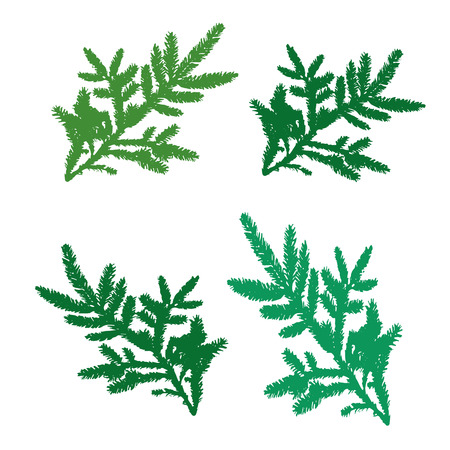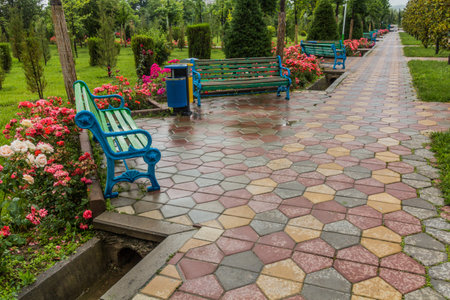Introduction to British Pathway Design
Pathways hold a special place in the heart of British garden design, weaving together beauty, tradition, and practicality. From the winding gravel walks of English country estates to the neat brick paths of urban courtyards, these routes are far more than simple connectors between spaces. They reflect centuries of horticultural heritage and reveal the thoughtful craftsmanship behind every British garden. Pathways provide structure and guide visitors through different areas, offering a sense of journey and discovery. At the same time, they highlight planting schemes, frame views, and help manage the unpredictable British weather by keeping shoes mud-free. Blending hard materials like stone or brick with lush greenery and soft groundcovers is a hallmark of classic British pathways, creating inviting routes that balance function with timeless appeal.
2. What are Hard and Soft Landscaping Elements?
When designing British pathways, it is important to understand the difference between hard and soft landscaping elements. These two components work together to create balanced, functional, and visually appealing outdoor spaces that reflect the local character and climate.
Hard Landscaping Elements
Hard landscaping refers to the structural, non-living features of a landscape. These materials provide the backbone for pathways and garden layouts, offering durability and formality. In the UK, common hard landscaping materials include:
| Material | Example in British Pathways |
|---|---|
| Stone | Yorkstone flagstones in traditional cottage gardens |
| Brick | Herringbone brick paths in Victorian terraces |
| Gravel | Cotswold gravel for informal country walkways |
| Paving Slabs | Concrete or sandstone slabs in contemporary patios |
Soft Landscaping Elements
Soft landscaping includes the living, growing elements of a garden. These features bring colour, texture, and seasonal interest to pathways. They also soften hard edges and help integrate the path into its surroundings. Typical soft landscaping elements in the UK are:
| Element | Example in British Pathways |
|---|---|
| Plants & Shrubs | Lavender borders along a stone path |
| Turf & Grass | Lawn strips between stepping stones or paving slabs |
| Moss & Groundcover | Moss growing between cobbles in shaded areas |
| Perennials & Bulbs | Daffodils or bluebells lining woodland walks in spring |
The Importance of Both Elements in British Design
British pathway design often blends these hard and soft elements to achieve harmony with both historic architecture and natural surroundings. For example, a formal Georgian garden might feature precise stone paths softened by clipped box hedges, while a country cottage could use winding gravel paths bordered by wildflowers. By thoughtfully combining hard and soft landscaping elements, designers can create inviting routes that feel authentically British and suit both practical needs and aesthetic aspirations.

3. Classic British Materials and Plants
In the UK, pathway design often celebrates a blend of traditional hard landscaping materials with timeless planting choices. York stone is one of the most iconic options for paving; its warm hues and natural texture fit seamlessly into both period gardens and contemporary spaces. Another popular choice is clay pavers, valued for their rustic character and durability. These materials not only offer visual appeal but also stand up well to British weather conditions.
When it comes to soft landscaping, British pathways are frequently framed or softened with classic plant selections. Lavender is a favourite for its fragrant scent and purple blooms, which attract pollinators and add colour along the edges of paths. Box hedging (Buxus sempervirens) is another staple, offering neat structure and evergreen formality—perfect for defining routes or creating striking contrasts with more relaxed plantings.
This careful pairing of hard surfaces like York stone or clay pavers with traditional plants such as lavender and box creates a distinctly British look. The result is a pathway that feels inviting, practical, and deeply rooted in local garden culture.
4. Achieving the Right Balance
Designing a British pathway that blends hard and soft landscaping elements is an exercise in harmony. The unpredictable UK weather, ranging from damp winters to occasional dry spells, means choices must be both attractive and practical. Here are some useful tips to help you achieve a balanced look and easy maintenance for your pathways.
Consider Local Climate and Plant Choices
Choose hardy, native plants that thrive in the UK’s climate. These require less water and are easier to care for. Pair them with permeable hard surfaces like gravel or setts, which allow rainwater to drain naturally and reduce puddling.
Practical Tips for Blending Elements
- Layer Textures: Combine smooth stone paving with soft, low-growing ground covers such as thyme or creeping Jenny along edges.
- Create Contrast: Use darker hard materials (e.g., slate) with lighter foliage, or vice versa, for visual interest.
- Maintain Clear Boundaries: Edging with brick or metal keeps plants tidy and paths defined.
- Plan for Access: Allow enough width for walking, wheelbarrows, or accessibility needs—especially when soft elements spill over the path.
Balancing Maintenance Requirements
| Element | Maintenance Level | British Example |
|---|---|---|
| Paving Stones | Low | Yorkstone slabs |
| Gravel | Medium (occasional topping up) | Cotswold chippings |
| Box Hedging | High (regular clipping) | Buxus sempervirens |
| Creeping Thyme | Low | Thymus serpyllum |
Sustainable Drainage Solutions
Avoid flooding by integrating soft landscaping features like rain gardens or permeable borders. This not only helps with drainage but also supports local wildlife.
Final Thoughts on Balance
The key is moderation: too much hardscape feels stark; too many plants can become unkempt. Aim for a thoughtful mix that echoes classic British charm while being functional all year round.
5. Sustainable and Wildlife-Friendly Choices
In recent years, British pathway design has increasingly embraced sustainability and wildlife-friendly practices, reflecting a broader commitment to eco-conscious living. When blending hard and soft landscaping elements, choosing environmentally responsible materials is essential. For hard landscaping, options like reclaimed York stone, permeable gravel, or recycled brick not only reduce environmental impact but also blend seamlessly with traditional British aesthetics. These materials allow rainwater to drain naturally, helping to prevent flooding and support healthy soil.
Equally important are planting strategies that prioritise local biodiversity. Incorporating native plant species along pathways provides essential food and shelter for pollinators such as bees, butterflies, and birds. Consider lining paths with wildflowers, lavender, or native grasses—these choices require less maintenance, thrive in the UK climate, and support local ecosystems. Integrating green corridors or small wildlife habitats beside walkways encourages hedgehogs and other garden visitors to flourish.
Sustainable gardening also means minimising chemical use. Using organic mulches and natural pest control methods helps maintain healthy soil life and reduces harm to beneficial insects. Rain gardens or swales alongside paths can capture runoff while offering habitats for amphibians and insects.
By thoughtfully combining durable, eco-friendly hardscape materials with biodiversity-boosting plantings, British garden pathways become both beautiful and environmentally responsible—enhancing the landscape while protecting the wildlife that makes our gardens vibrant.
6. Inspirational Examples from UK Gardens
British gardens are celebrated worldwide for their masterful blending of hard and soft landscaping elements. Here are a few standout examples that beautifully showcase this harmonious integration:
Sissinghurst Castle Garden, Kent
This iconic garden, designed by Vita Sackville-West, demonstrates the seamless use of brick pathways bordered by lush perennial planting. The hard surfaces provide structure and guide visitors, while the abundant soft planting softens the lines and brings movement and colour throughout the seasons.
Great Dixter, East Sussex
At Great Dixter, gravel paths wind through exuberant mixed borders. The contrast between the naturalistic planting style and the crisp, defined edges of the paths highlights how hard landscaping can frame and enhance the softness of surrounding vegetation.
Royal Botanic Gardens, Kew
Kew Gardens features both formal and informal routes, using materials like York stone paving amidst sweeping lawns and vibrant flower beds. The combination encourages exploration while ensuring accessibility for all visitors. This thoughtful integration enhances the visitor experience by balancing practical needs with aesthetic beauty.
The High Line-Inspired Garden at RHS Wisley
Wisley’s recent garden additions include raised walkways and platforms surrounded by grasses and perennials. Timber decking contrasts with swathes of soft planting, offering new perspectives while maintaining a connection with nature.
Key Takeaways
These British gardens exemplify how blending hard materials—like stone, brick, or timber—with thoughtfully chosen plants creates inviting, functional spaces. Each example underscores that successful pathway design depends on achieving a balance: structure from hard landscaping supports and enhances the living beauty of soft elements. By drawing inspiration from these renowned locations, designers can create pathways that feel both grounded and full of life.

